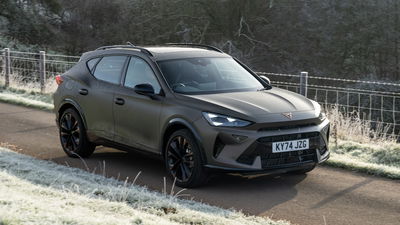Volkswagen Touareg Review: A Well-Measured SUV, But The R’s To Be Avoided

Pros
- Refined at cruising speedsV6 diesel feels right at home
Cons
- Mildly infuriating infotainment controlsThe Porsche Cayenne exists
Volkswagen is among the biggest culprits in the world of pseudo-SUVs we live in. Among its current range are the T-Cross, T-Roc, Taigo and Tiguan - all of which could be argued lean into the idea of a big, off-road capable comfy bruiser without delivering any of the technical capabilities. And that’s without diving into the other brands within the Volkswagen Group…
It shouldn’t be forgotten though that the German giant knows how to make an SUV properly. Since its introduction in 2002, the Touareg has long proven itself as a seriously capable high-rider and now serves as Volkswagen’s flagship car - offering the best of the brand.
In its third iteration, available since 2018, the Touareg has established itself as a smart-looking, excellently equipped and well-rounded machine. However, it’s always had a problem - and that’s the flexibility of the platform it lies upon.

The MLB Evo underpinnings can be found in the Porsche Cayenne, Audi Q7, Lamborghini Urus and Bentley Bentayga. While that’s a testament to just how solid the Touareg’s bones are, it’s always felt a bit upstaged - particularly so by the Cayenne, which has never been greatly out of reach price-wise.
That said, it doesn’t take long behind the wheel to appreciate the strengths of the Touareg. Not much has changed mechanically for the car in its facelift - additions to help driving comfort are limited to some extra padding on the doors and centre console to rest yourself on - but that’s certainly no bad thing.
What the Touareg does best is cruising at speed. Very little noise comes into the cabin despite having huge wheels and plenty of mass, and the ride is especially comfortable on air suspension. Standard-fit steel springs aren’t bad, but a drive back-to-back of the two systems revealed just how much better the car sits on a pneumatic system.

It’s a setup best paired with the V6 diesel. It’s easy to decry a big oil burner in 2023, but the 3.0-litre unit suits the SUV perfectly. 282bhp and a 6.4 second 0-62mph is more than enough for the car, and in the real world, its low-end torque gives an effortless feel to progression. It helps that the eight-speed torque converter is smooth and responsive enough, too.
Granted, at a tested WLTP economy figure of 34.4mpg (and 29mpg in our time with the car), it doesn’t offer the economy plug-in hybrid versions promise to. A quick sprint in the 376bhp didn’t give us the answer as to how that turns out in the real world but revealed a bit of a mismatch between powertrain and car.
You lose that seamless progression of the diesel, and there’s a distinct disconnect between when the engine takes over from the electric motor. You’ll need to keep on top of charges too the make the most of the battery’s economy - a quoted 31 miles of range is some distance behind a Cayenne e-Hybrid’s 46-mile offering, and once that’s gone you’ve got a 3.0-litre turbocharged V6 shifting 2.4 tonnes of SUV.

Dynamically as well, the Touareg lags behind the Cayenne - though that’s no surprise. Steering is vague at best and particularly in the plug-in hybrid car, it doesn’t do a fantastic job of hiding its weight. You do get a little more confidence from the air suspension compared with the standard-fit steel springs, which do introduce some twitchiness in rougher surfaces, but both insulate you a lot from the road feel.
That’s not a disappointment for standard versions of the Touareg, but sadly the same principle applies to the R from a very limited run in the car (we had about 20 minutes on some back roads). You do feel the extra punch from its uprated plug-in hybrid powertrain, with a peak output of 456bhp, but it’s hardly scintillating and dynamically feels virtually identical to the base car. Cynically, it feels like an exercise in marketing the R brand rather than a true performance SUV.
As we mentioned earlier, interior revisions are largely concentrated on some extra padding and a larger infotainment screen. Not that much more was needed - the Toaureg remains an exceptional place to sit, and the build quality feels leaps ahead of anything else with a VW moniker in. If you blanked the badging and told someone it was an Audi, we suspect they wouldn’t question it.

Points off for the infotainment system, though. The 15-inch screen looks sharp, but it’s very tricky to navigate on the move. There are sub-menus within menus, and no physical shortcut buttons leave you looking towards the display more often than we’d like. Climate controls embedded within are a pain to use as well, and using nine bars for three stages of heat seating is mildly irritating.
All-in, the Volkswagen Touareg is well-measured though, and serves as an excellent way to cover a ton of miles in lots of comfort. Our pick of the range would be the Black Edition diesel, with the powertrain feeling like the car was designed around it.
The biggest issue with the Touareg isn’t really one of its own making, though. With a starting price of £67,780, badge snobs will likely struggle to consider it over the ever so slightly cheaper Audi Q7. And of course, a Porsche Cayenne can be yours from £70,400, which does everything just a little bit better. Bring it down to the monthly payments, and there’s not much in it…















Comments
No comments found.